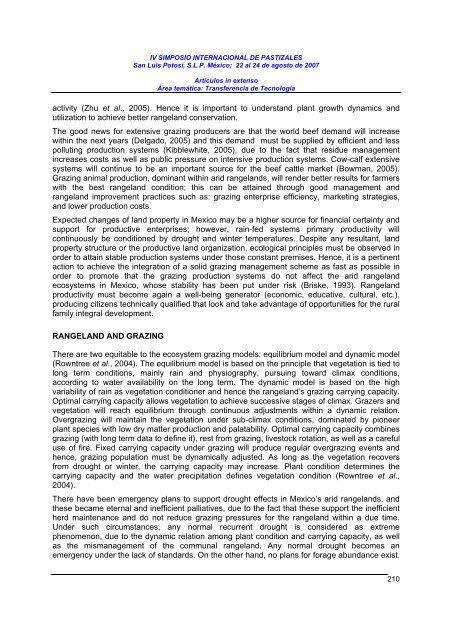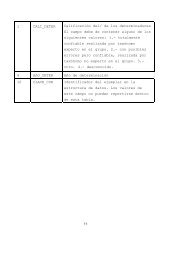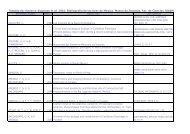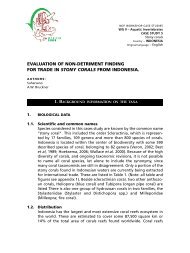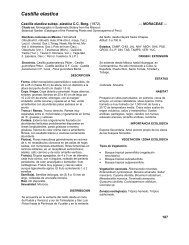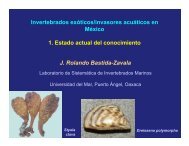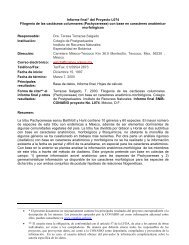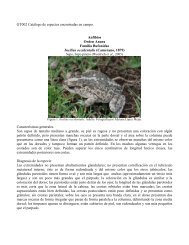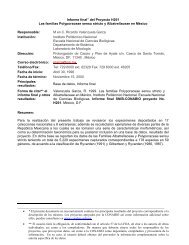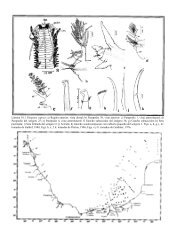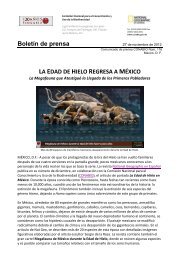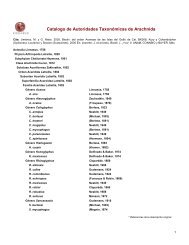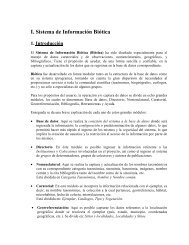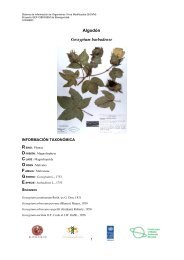ecosystem services to and from north american arid ... - Conabio
ecosystem services to and from north american arid ... - Conabio
ecosystem services to and from north american arid ... - Conabio
You also want an ePaper? Increase the reach of your titles
YUMPU automatically turns print PDFs into web optimized ePapers that Google loves.
IV SIMPOSIO INTERNACIONAL DE PASTIZALES<br />
San Luis Po<strong>to</strong>sí, S.L.P. México; 22 al 24 de agos<strong>to</strong> de 2007<br />
Artículos in extenso<br />
Área temática: Transferencia de Tecnología<br />
activity (Zhu et al., 2005). Hence it is important <strong>to</strong> underst<strong>and</strong> plant growth dynamics <strong>and</strong><br />
utilization <strong>to</strong> achieve better rangel<strong>and</strong> conservation.<br />
The good news for extensive grazing producers are that the world beef dem<strong>and</strong> will increase<br />
within the next years (Delgado, 2005) <strong>and</strong> this dem<strong>and</strong> must be supplied by efficient <strong>and</strong> less<br />
polluting production systems (Kibblewhite, 2005), due <strong>to</strong> the fact that residue management<br />
increases costs as well as public pressure on intensive production systems. Cow-calf extensive<br />
systems will continue <strong>to</strong> be an important source for the beef cattle market (Bowman, 2005).<br />
Grazing animal production, dominant within <strong>arid</strong> rangel<strong>and</strong>s, will render better results for farmers<br />
with the best rangel<strong>and</strong> condition; this can be attained through good management <strong>and</strong><br />
rangel<strong>and</strong> improvement practices such as: grazing enterprise efficiency, marketing strategies,<br />
<strong>and</strong> lower production costs.<br />
Expected changes of l<strong>and</strong> property in Mexico may be a higher source for financial certainty <strong>and</strong><br />
support for productive enterprises; however, rain-fed systems primary productivity will<br />
continuously be conditioned by drought <strong>and</strong> winter temperatures. Despite any resultant, l<strong>and</strong><br />
property structure or the productive l<strong>and</strong> organization, ecological principles must be observed in<br />
order <strong>to</strong> attain stable production systems under those constant premises. Hence, it is a pertinent<br />
action <strong>to</strong> achieve the integration of a solid grazing management scheme as fast as possible in<br />
order <strong>to</strong> promote that the grazing production systems do not affect the <strong>arid</strong> rangel<strong>and</strong><br />
<strong>ecosystem</strong>s in Mexico, whose stability has been put under risk (Briske, 1993). Rangel<strong>and</strong><br />
productivity must become again a well-being genera<strong>to</strong>r (economic, educative, cultural, etc.),<br />
producing citizens technically qualified that look <strong>and</strong> take advantage of opportunities for the rural<br />
family integral development.<br />
RANGELAND AND GRAZING<br />
There are two equitable <strong>to</strong> the <strong>ecosystem</strong> grazing models: equilibrium model <strong>and</strong> dynamic model<br />
(Rowntree et al., 2004). The equilibrium model is based on the principle that vegetation is tied <strong>to</strong><br />
long term conditions, mainly rain <strong>and</strong> physiography, pursuing <strong>to</strong>ward climax conditions,<br />
according <strong>to</strong> water availability on the long term. The dynamic model is based on the high<br />
variability of rain as vegetation conditioner <strong>and</strong> hence the rangel<strong>and</strong>’s grazing carrying capacity.<br />
Optimal carrying capacity allows vegetation <strong>to</strong> achieve successive stages of climax. Grazers <strong>and</strong><br />
vegetation will reach equilibrium through continuous adjustments within a dynamic relation.<br />
Overgrazing will maintain the vegetation under sub-climax conditions, dominated by pioneer<br />
plant species with low dry matter production <strong>and</strong> palatability. Optimal carrying capacity combines<br />
grazing (with long term data <strong>to</strong> define it), rest <strong>from</strong> grazing, lives<strong>to</strong>ck rotation, as well as a careful<br />
use of fire. Fixed carrying capacity under grazing will produce regular overgrazing events <strong>and</strong><br />
hence, grazing population must be dynamically adjusted. As long as the vegetation recovers<br />
<strong>from</strong> drought or winter, the carrying capacity may increase. Plant condition determines the<br />
carrying capacity <strong>and</strong> the water precipitation defines vegetation condition (Rowntree et al.,<br />
2004).<br />
There have been emergency plans <strong>to</strong> support drought effects in Mexico’s <strong>arid</strong> rangel<strong>and</strong>s, <strong>and</strong><br />
these became eternal <strong>and</strong> inefficient palliatives, due <strong>to</strong> the fact that these support the inefficient<br />
herd maintenance <strong>and</strong> do not reduce grazing pressures for the rangel<strong>and</strong> within a due time.<br />
Under such circumstances, any normal recurrent drought is considered as extreme<br />
phenomenon, due <strong>to</strong> the dynamic relation among plant condition <strong>and</strong> carrying capacity, as well<br />
as the mismanagement of the communal rangel<strong>and</strong>. Any normal drought becomes an<br />
emergency under the lack of st<strong>and</strong>ards. On the other h<strong>and</strong>, no plans for forage abundance exist.<br />
210


